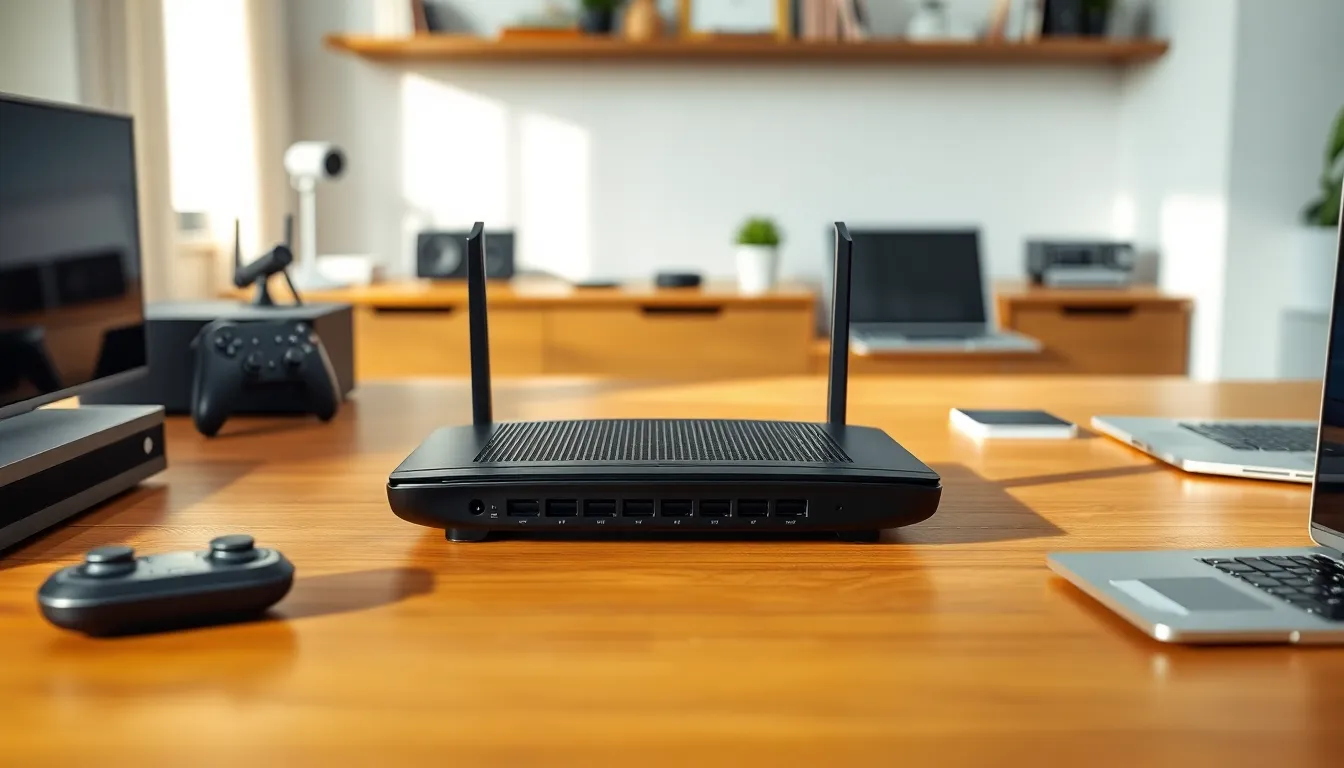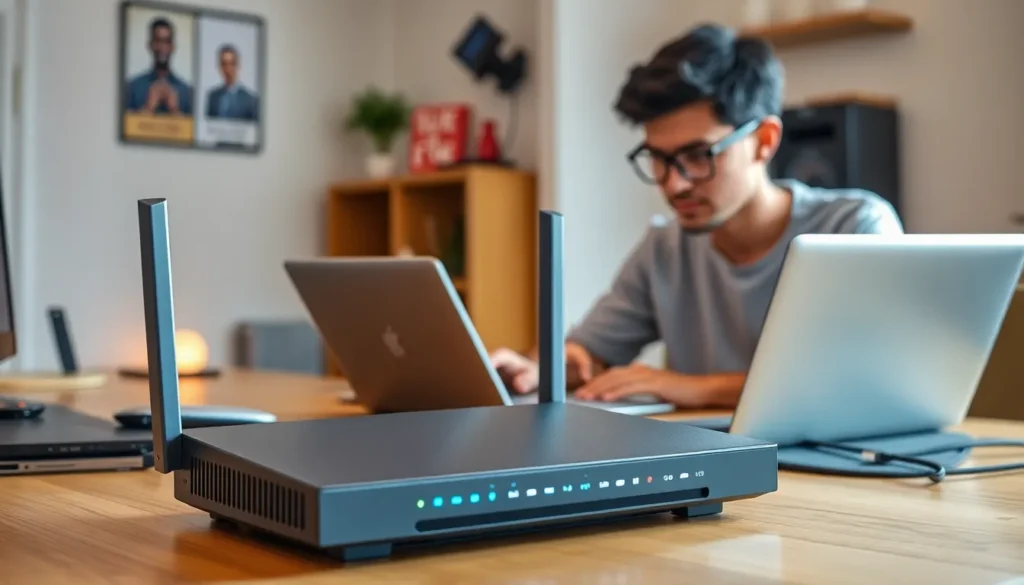In a world where streaming, gaming, and remote work reign supreme, router port forwarding is the unsung hero of home networks. Imagine trying to stream your favorite show while your partner’s online gaming session turns your Wi-Fi into a digital wrestling match. Fear not! Port forwarding swoops in like a superhero, ensuring smooth connections and seamless experiences.
Table of Contents
ToggleWhat Is Router Port Forwarding?
Router port forwarding directs specific traffic from the internet to a designated device within a local network. This process enables efficient communication for applications that require direct access, such as gaming consoles, security cameras, or web servers.
Devices within a home network typically share a single public IP address assigned by an Internet Service Provider (ISP). Port forwarding associates this public IP with specific ports, hence allowing external devices access to designated internal resources. This connection enhances reliability for real-time data applications by minimizing issues linked to firewalls and Network Address Translation (NAT).
A common use case for port forwarding is online gaming. Games often demand stable, direct connections to function optimally. With port forwarding configured, players experience reduced latency and increased performance, facilitating smoother gameplay.
Security cameras also benefit from port forwarding, enabling users to view live feeds remotely. By forwarding the relevant port to the camera’s internal IP, users can access feeds securely over the internet.
Notably, port forwarding requires a few steps in the router’s configuration. Users must log into the router’s web interface, identify the port number associated with their application, and assign that port to the appropriate internal device. Detailed guides often accompany specific router models, ensuring users can navigate this setup effectively.
Using router port forwarding not only optimizes connectivity but also maximizes the functionality of networked devices. This method plays a critical role in managing home networks that support multiple simultaneous activities.
Why Is Port Forwarding Important?

Port forwarding plays a vital role in enhancing network performance and reliability. It streamlines data transmission between external services and devices within a local network.
Benefits of Port Forwarding
Directing specific traffic improves connectivity by reducing latency and increasing reliability. Enhanced performance leads to better experiences, particularly for real-time applications. It allows external devices to communicate effectively with internal resources. By facilitating access, it also supports a variety of applications, allowing users to take full advantage of their network. Furthermore, it helps users manage multiple devices simultaneously, optimizing overall network functionality.
Common Use Cases
Online gaming stands out as a primary use case, where port forwarding reduces latency and enhances gameplay experiences. Security cameras benefit from this feature as well, enabling users to access live feeds from anywhere. Hosting web servers requires port forwarding too, ensuring that users can reach hosted content without disruption. Additionally, remote access applications utilize port forwarding, allowing users to control devices outside their home network. Each of these cases illustrates how integral port forwarding is to a seamless digital experience.
How to Set Up Router Port Forwarding
Setting up router port forwarding enhances network performance and facilitates remote access to devices. Follow these steps to configure port forwarding effectively.
Accessing Your Router’s Settings
Log into your router’s web interface using a web browser. Input the router’s IP address in the address bar, typically found on the device’s label. Enter the admin credentials; the default ones are often “admin” for both username and password. Navigate to the settings menu; this can vary by router brand but usually appears as “Advanced” or “Network.” Locate the port forwarding section, often under “Firewall” or “NAT.” Once there, you’re ready to add port forwarding rules.
Configuring Port Forwarding Rules
Identify the specific device for which you want to enable port forwarding. Each device’s local IP address must be noted; use the command prompt or device settings to find it. Determine the required port numbers based on the applications needing access, such as UDP or TCP ports for gaming or streaming. Create a new port forwarding rule by entering the device’s IP address and designated port numbers. Save changes and apply the new settings, ensuring you reboot the router if necessary. Test connectivity to confirm the configuration works correctly.
Troubleshooting Port Forwarding Issues
Port forwarding can sometimes present challenges. Identifying and resolving these issues ensures smooth connectivity.
Common Problems and Solutions
Inconsistent connectivity often arises from incorrect IP addresses. Users should verify that the internal IP address matches the device they intend to forward traffic to. Misconfigured port numbers can also create barriers. Ensure the correct ports are specified in the router’s settings.
Firewalls can block incoming requests, affecting accessibility. Temporarily disabling firewalls helps diagnose this issue. Network Address Translation (NAT) settings might interfere as well. If the router utilizes strict NAT, consider changing it to moderate or open.
Conflicts with multiple devices pose significant problems too. Each device should have a unique internal IP address to avoid conflicts. Users must also confirm their router’s firmware is up-to-date. An outdated firmware can lead to compatibility issues with port forwarding protocols.
Lastly, testing the configuration using online port checkers assists in verifying successful setups. Successful checks indicate that port forwarding functions correctly, while failures point to further troubleshooting needs.
Security Considerations
Port forwarding improves connectivity but poses security risks that require careful management. Exposing internal devices to the internet increases vulnerability to unauthorized access. Users should implement measures to secure exposed devices.
Regularly updating firmware on the router minimizes security gaps. Strong passwords for the router and individual devices help prevent unauthorized attempts to gain access. Configuring the router’s firewall correctly adds another layer of protection against intrusions.
Limiting the number of exposed ports reduces the attack surface. Specific use cases benefit from forwarding only essential ports, leading to improved security. For example, gaming may require specific ports, while other services may not need exposure.
Monitoring network activity assists in detecting unusual behavior. Network monitoring tools can alert users to potential security threats. Keeping an eye on logs may reveal unauthorized access attempts.
Assigning static IP addresses to internal devices aids in managing port forwarding settings. Static addresses ensure that rules remain consistent, preventing misconfiguration. This streamlines the process while maintaining security.
Disabling unused services prevents potential exploitation. If a device doesn’t require external access, keeping it off the forward list enhances safety. Regularly reviewing port forwarding rules and deleting unnecessary entries strengthens network security.
Using Virtual Private Network (VPN) connections for remote access adds encryption. This secures data transmitted between internal devices and external users. VPNs provide an additional safeguard against intercepted communication.
Overall, evaluating security implications before enabling port forwarding ensures a balance between connectivity and protection. Adopting best practices not only secures the network but also enhances user peace of mind.
Router port forwarding is an essential tool for optimizing home network performance. By directing traffic efficiently to specific devices, it enhances the experience for users engaged in gaming, remote work, or streaming.
While it offers significant benefits in connectivity and functionality, maintaining security is equally important. Users must remain vigilant about potential vulnerabilities associated with exposing internal devices.
With the right configurations and security measures in place, individuals can fully leverage their network’s capabilities while enjoying seamless access to their devices. Embracing port forwarding can lead to a more reliable and efficient online experience.




